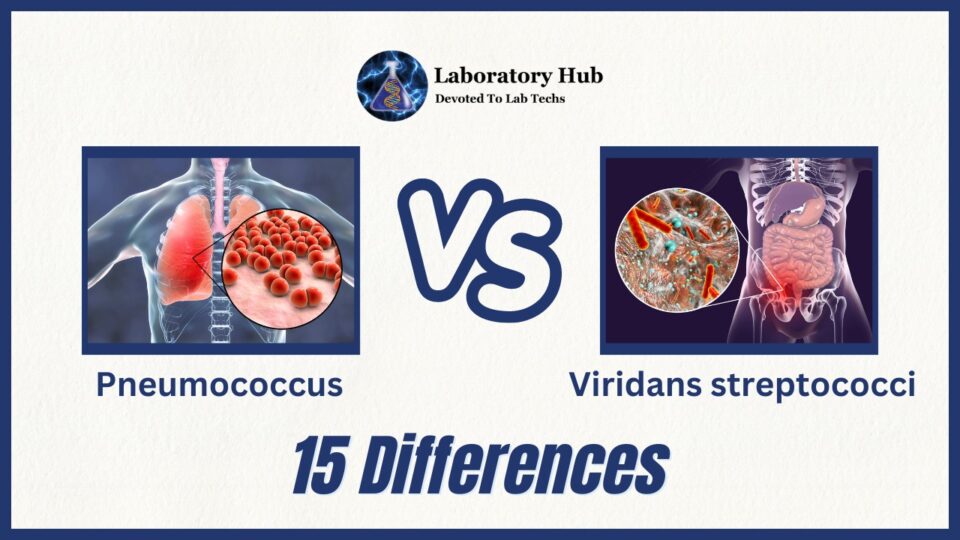Bacteria—beneficial and harmful—are important in the microbiological world. Streptococcus species inhabit several human body niches. Due to their health effects, Pneumococcus and Viridans Streptococcus have received attention. Despite sharing a genus, these two species have different traits, behaviors, and health effects.
Gram-positive Streptococcus pneumoniae causes pneumonia, meningitis, and sepsis. This capsule helps the bacterium’s pathogenicity and immune system evasion. Pneumococcus is a prominent source of illness and mortality globally, especially in children, the elderly, and those with compromised immune systems.
Viridans Streptococcus is a diverse group of streptococcal species found in the mouth cavity, upper respiratory tract, and gastrointestinal system. Viridans Streptococcus, unlike Pneumococcus, lacks a capsule. Though commensals, some bacteria can become opportunistic pathogens and cause illnesses. Viridans Streptococcus causes dental caries, endocarditis, and abscesses, especially in people with poor oral or heart health.
READ ALSO: Neisseria meningitidis vs Neisseria gonorrhoeae- 30 Differences
Pneumococcus and Viridans Streptococcus vary beyond pathogenicity. Pneumococcus colonizes and invades host tissues with its effective polysaccharide capsule. Viridans Streptococcus uses adhesive molecules and extracellular enzymes to stick to host surfaces and avoid immune responses. These changes affect disease transmission and clinical symptoms.
Diagnosis, treatment, and prevention require knowledge of Pneumococcus and Viridans Streptococcus. Selecting suitable medications and combating antibiotic resistance requires accurate causal agent identification. Understanding their pathogenicity and virulence pathways helps create targeted treatments and vaccines.
We shall examine Pneumococcus and Viridans Streptococcus’ distinctive traits, clinical manifestations, epidemiology, and diagnostic methods. We can improve public health, patient outcomes, and innovative therapies to fight these key microbial foes by studying these microorganisms.
|
S.No. |
Category |
Pneumococcus |
Viridans Streptococci |
|
1 |
Habitat |
Normally resides in the upper respiratory tract of humans. |
Found in the oral cavity, gastrointestinal tract, and genitourinary tract. |
|
2 |
Pathogenicity |
Can cause serious infections such as pneumonia, meningitis, and sepsis. |
Mostly opportunistic pathogens causing dental and oral infections. |
|
3 |
Capsule |
Typically encapsulated with a polysaccharide capsule. |
Non-capsulated or weakly encapsulated. |
|
4 |
Optochin Sensitivity |
Pneumococcus is optochin-sensitive. |
Viridans streptococci are optochin-resistant. |
|
5 |
Hemolysis |
Pneumococcus can exhibit alpha-hemolysis or partial hemolysis. |
Viridans streptococci can exhibit alpha-hemolysis or non-hemolytic. |
|
6 |
Colonization |
Colonizes the nasopharynx and can spread to other sites in the body. |
Primarily colonizes the oral cavity and can cause dental plaque. |
|
7 |
Virulence Factors |
Possesses various virulence factors such as pneumolysin and autolysin. |
Exhibits a range of virulence factors, including adhesins and enzymes. |
|
8 |
Disease Associations |
Associated with pneumonia, otitis media, sinusitis, and invasive infections. |
Associated with dental caries, endocarditis, and abscess formation. |
|
9 |
Vaccine Availability |
Vaccines are available against specific serotypes of pneumococcus. |
No specific vaccine is available for viridans streptococci. |
|
10 |
Antibiotic Susceptibility |
Some strains of pneumococcus have developed antibiotic resistance. |
Viridans streptococci can exhibit variable antibiotic susceptibility. |
|
11 |
Quellung Reaction |
Pneumococcus can show a positive Quellung reaction, indicating capsule swelling. |
Viridans streptococci do not typically show a positive Quellung reaction. |
|
12 |
Endocarditis |
Pneumococcus is a less common cause of infective endocarditis. |
Viridans streptococci are one of the major causes of infective endocarditis. |
|
13 |
Dental Health |
Pneumococcus does not have a significant impact on dental health. |
Viridans streptococci are associated with dental plaque and dental caries. |
|
14 |
Biofilm Formation |
Pneumococcus can form biofilms on various surfaces, contributing to pathogenicity. |
Viridans streptococci are known for their ability to form biofilms in the oral cavity. |
|
15 |
Species Examples |
Streptococcus pneumoniae is the main species of pneumococcus. |
Streptococcus mutans and Streptococcus mitis are examples of viridans streptococci. |
Frequently Asked Questions (FAQs)
Q1. What distinguishes Pneumococcus from Viridans Streptococcus?
Pneumococcus and Viridans are Streptococcus species. Encapsulated pneumococcus can colonize host tissues and increase its pathogenicity due to its polysaccharide capsule. Viridans Streptococcus, which lacks a capsule, adheres to host surfaces through adhesive molecules and extracellular enzymes. Their virulence factors impact illness and clinical symptoms.
Q2. What diseases are caused by Pneumococcus and Viridans Streptococcus?
Pneumococcus causes pneumonia, sinusitis, and otitis media. It causes meningitis and bloodstream infections. However, Viridans Streptococcus causes tooth cavities and oral infections. It can also cause endocarditis, abscesses, and other bodily infections, especially in people with poor dental health or heart issues.
Q3. How are Pneumococcus and Viridans Streptococcus diagnosed?
Sputum, blood, or oral swabs and laboratory testing are used to diagnose Pneumococcus and Viridans Streptococcus infections. Initial identification uses gram staining, culture, and biochemical testing. Molecular methods like PCR can improve detection speed and accuracy.
Q4. How are Pneumococcus and Viridans Streptococcus infections?
Antibiotics treat Pneumococcus and Viridans Streptococcus infections. Antibiotics depend on species, antimicrobial susceptibility, and infection location. Pneumococcus has grown increasingly resistant to antibiotics, underscoring the need for antibiotic selection based on local resistance trends. Endocarditis requires surgery.
Q5. What are the vaccines for Pneumococcus and Viridans Streptococcus?
Pneumococcus vaccinations exist. PCVs and PPVs prevent pneumococcal infections in high-risk groups including children and the elderly. These vaccines cannot protect against Viridans Streptococcus infections because this species is exceedingly diverse and lacks a common antigenic target. Oral hygiene and treating risk factors including dental disease and heart disease are the major ways to prevent Viridans Streptococcus infections.
User Review
( vote)
Laboratory Hub aims to provide the Medical Laboratory Protocols & General Medical Information in the most easy to understand language so that the Laboratory Technologist can learn and perform various laboratory tests with ease. If you want any protocol to be published on Laboratory Hub, Please drop a mail at contact@laboratoryhub.com. Happy Learning!

